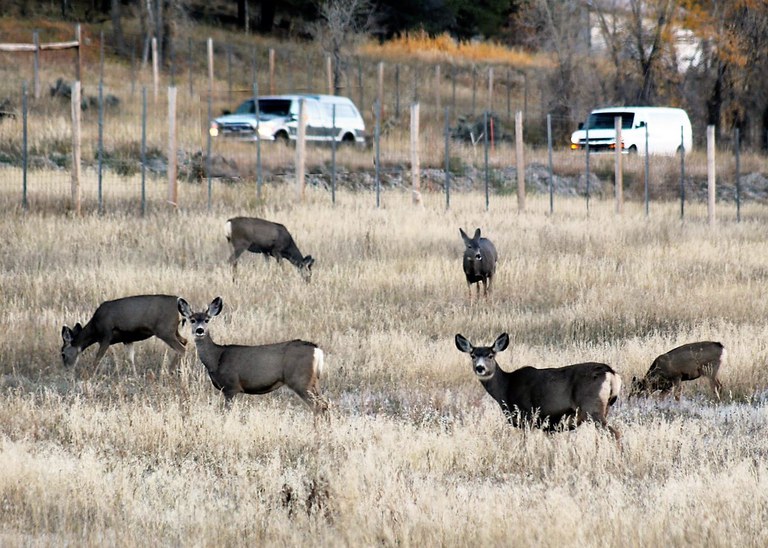Wildlife on the Move
News Release

CDOT PHOTO: The high fencing along this section of roadway prevents mule deer from crossing the highway and creating a potential vehicle crash. During fall months, big game will attempt to cross many Colorado roads as they migrate to lower elevations in search of food and water sources.
As spring and summer fade into fall and winter, the migration of wildlife can lead to an increase of wildlife-vehicle collisions during the fall and winter seasons.
Motorists should be aware that wildlife can cross roads without warning at any time of day or night, but drivers should pay particularly close attention in early morning and evening hours. A majority of wildlife-vehicle collisions occur from dusk to dawn, when wildlife are more active and unfortunately more difficult to see.
The following precautions are advised to travelers:
-
Slow down. Traveling at high speeds increases the danger of a crash. Moderate speeds maintain a driver’s reaction time and allow an appropriate response to animals on or near roads.
-
Stay alert. Pay close attention to the roadway, particularly while driving between dusk and dawn. This is when deer and other common wildlife are most active and more likely to be crossing roadways. Flickering headlights from oncoming cars or tail lights of the vehicles in front of you, may indicate an animal crossing the road.
-
Scan ahead. Watch for movement and shining eyes along roadsides. If you see one animal, you should expect it will be accompanied by others.
-
Obey traffic signs. Many highways have wildlife warning signs intended to alert motorists of known wildlife movement areas. Though incidents can happen anywhere, transportation authorities attempt to reduce the number of wildlife-vehicle collisions by posting signage and lowering speeds in areas where wildlife are active.
-
Give warning. When animals are seen on or near the road, slow down or stop (if no other cars are behind you), honk the horn and flash headlights. This warns the animal to avoid the road and alerts other drivers in oncoming vehicles to the potential hazard.
-
Always wear seat belts. Unfortunately, not every collision is avoidable, and the National Highway and Traffic Safety Administration states that the risk of serious injury and death in a crash is reduced by half when seat belts are worn.
Drivers involved in a wildlife-vehicle collision should report the accident to the Colorado State Patrol by calling *CSP (star key and 277). Should a crash with wildlife occur, remember to slow down and concentrate on retaining control of the vehicle, be aware of your surroundings, especially other vehicles, and move your vehicle to a safe position off the road.
COVID-19
Safe transportation infrastructure is essential for all of us, particularly for emergency first responders and freight drivers as Colorado navigates the COVID-19 pandemic. With that in mind, CDOT maintenance and construction crews follow social distancing and other health safety measures to reduce COVID-19 exposure on the worksite. The Colorado Department of Public Health and Environment announced guidelines for construction activities. The public is urged to join the campaign for #DoingMyPartCO by practicing social distancing and wearing face masks. As traffic returns to normal levels, motorists must drive cautiously and heed the speed limit so all of us can return home safely.
WHOLE SYSTEM. WHOLE SAFETY.
In early 2019, CDOT announced its Whole System — Whole Safety initiative to heighten safety awareness. This initiative takes a systematic statewide approach to safety combining the benefits of CDOT’s programs that address driving behaviors, our built environment and the organization's operations. The goal is to improve the safety of Colorado’s transportation network by reducing the rate and severity of crashes and improving the safety of all transportation modes. The program has one simple mission—to get everyone home safely.
ABOUT CDOT
CDOT has approximately 3,000 employees located throughout Colorado, and manages more than 23,000 lane miles of highway and 3,429 bridges. CDOT also manages grant partnerships with a range of other agencies, including metropolitan planning organizations, local governments and airports. It also administers Bustang, the state-owned and operated inter-regional express service. Gov. Polis has charged CDOT to further build on the state’s multimodal mobility options.
